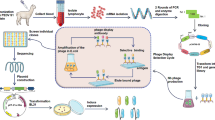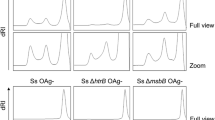Abstract
Vibrio cholerae is considered one of the major health threats in developing countries. Lack of efficient vaccine, short incubating time of the disease, and bacterium ability to survive in aquatic environment have made cholera one of the most epidemic diseases yet known. The lipopolysaccharide is one of the bacterium key antigens used to classify V. cholerae into 206 serogroups. V. cholerae serogroup O1 is a causative agent of all cholera pandemics. Research has shown that anti-lipopolysaccharide (LPS) antibodies could provide protective immunity in cholera cases. In this research, we used N-terminal fragments of the camel's heavy-chain antibodies called VHH or nanobodies and produced a phagemid library. The obtained library was panned against V. cholerae O1 LPS, and four monoclonal nanobodies were isolated. Isolated nanobodies were tested in LPS ELISA and bacterial ELISA. The nanobody with the highest affinity toward the bacterium was used in an in vivo challenge and successfully neutralized the bacterium infection. The isolated nanobody showed high thermostability and proteolytic resistance in characterization tests.






Similar content being viewed by others
References
Alam M, Hasan NA, Sadique A, Bhuiyan N, Ahmed KU, Nusrin S, Nair GB, Siddique A, Sack RB, Sack DA (2006) Seasonal cholera caused by Vibrio cholerae serogroups O1 and O139 in the coastal aquatic environment of Bangladesh. Appl Environ Microbiol 72(6):4096–4104
Alam M, Sultana M, Nair GB, Siddique A, Hasan NA, Sack RB, Sack DA, Ahmed K, Sadique A, Watanabe H (2007) Viable but nonculturable Vibrio cholerae O1 in biofilms in the aquatic environment and their role in cholera transmission. Proc Natl Acad Sci 104(45):17801
Ashbolt NJ (2004) Microbial contamination of drinking water and disease outcomes in developing regions. Toxicology 198(1):229–238
Beatty JD, Beatty BG, Vlahos WG (1987) Measurement of monoclonal antibody affinity by non-competitive enzyme immunoassay. J Immunol Methods 100(1–2):173–179
Behdani M, Zeinali S, Khanahmad H, Karimipour M, Asadzadeh N, Azadmanesh K, Khabiri A, Schoonooghe S, Habibi Anbouhi M, Hassanzadeh-Ghassabeh G (2011) Generation and characterization of a functional nanobody against the vascular endothelial growth factor receptor-2; angiogenesis cell receptor. Mol Immunol 50:35–41
Bhattacharya K, Kanungo S, Sur D, Sarkar BL, Manna B, Lopez AL, Bhattacharya M, Nandy S, Niyogi SK (2011) Tetracycline-resistant Vibrio cholerae O1, Kolkata, India. Emerg Infect Dis 17(3):568
Bhunia R, Ramakrishnan R, Hutin Y, Gupte MD (2009) Cholera outbreak secondary to contaminated pipe water in an urban area, West Bengal, India, 2006. Indian J Gastroenterol 28(2):62–64
Bishop AL, Schild S, Patimalla B, Klein B, Camilli A (2010) Mucosal immunization with Vibrio cholerae outer membrane vesicles provides maternal protection mediated by antilipopolysaccharide antibodies that inhibit bacterial motility. Infect Immun 78(10):4402–4420
Bradford MM (1976) A rapid and sensitive method for the quantitation of microgram quantities of protein utilizing the principle of protein-dye binding. Anal Biochem 72(1–2):248–254
Bronze MS, Greenfield RA (eds) (2005) Biodefense: principles and pathogens. Horizon bioscience, Greenfield, 838 pp
Brooks GF, Butel JS, Morse SA (2004) Jawetz, Melnick, & Adelberg’s medical microbiology. McGraw-Hill, USA, 880 pp
Dharmasena MN, Krebs SJ, Taylor RK (2009) Characterization of a novel protective monoclonal antibody that recognizes an epitope common to Vibrio cholerae Ogawa and Inaba serotypes. Microbiology 155(7):2353–2364
Dubois M, Gilles KA, Hamilton JK, Rebers P, Smith F (1956) Colorimetric method for determination of sugars and related substances. Anal Chem 28(3):350–356
Faruque SM, Sack DA, Sack RB, Colwell RR, Takeda Y, Nair GB (2003) Emergence and evolution of Vibrio cholerae O139. Proc Natl Acad Sci U S A 100(3):1304
Ghassabeh GH, Muyldermans S, Saerens D (2010) Nanobodies, single-domain antigen-binding fragments of camelid heavy-chain antibodies. In: Shire SJ, Gombotz W, Bechtold-Peters K, Andya J (eds) Current trends in monoclonal antibody development and manufacturing. Springer, New York, pp 29–48
Goodchild S, Hopkins N, Love T, Patel V, Houghton B, Mayers C (2004) Engineering antibodies to detect biological warfare agents. DTIC Document
Haley BJ, Grim CJ, Hasan NA, Taviani E, Chun J, Brettin TS, Bruce DC, Challacombe JF, Detter JC, Han CS (2010) The pre-seventh pandemic Vibrio cholerae BX 330286 El Tor genome: evidence for the environment as a genome reservoir. Environ Microbiol Rep 2(1):208–216
Harmsen M, De Haard H (2007) Properties, production, and applications of camelid single-domain antibody fragments. Appl Microbiol Biotechnol 77(1):13–22
Harris AM, Bhuiyan MS, Chowdhury F, Khan AI, Hossain A, Kendall EA, Rahman A, LaRocque RC, Wrammert J, Ryan ET (2009) Antigen-specific memory B-cell responses to Vibrio cholerae O1 infection in Bangladesh. Infect Immun 77(9):3850–3856
Huang L, Muyldermans S, Saerens D (2010) Nanobodies: proficient tools in diagnostics. Expert Rev Mol Diagn 10(6):777–785
Igbinosa EO, Okoh AI (2008) Emerging Vibrio species: an unending threat to public health in developing countries. Res Microbiol 159(7):495–506
Igbinosa EO, Okoh AI (2009) Toxigenic Vibrio cholerae strains and their associated malaises. Afr J Microbiol Res 3(5):200–211
Kolkman JA, Law DA (2010) Nanobodies—from llamas to therapeutic proteins. Drug Discov Today: Technol 7(2):e139–e146
Krickeberg K, Pham V, Pham T (2012) Diarrhoea and Cholera. In: Epidemiology. Statistics for Biology and Health. Springer, New York, pp 47–52. doi:10.1007/978-1-4614-1205-2_6
Laeremans T, Van Bergen PPMP (2010) Camelidae single domain antibodies vhh directed against epidermal growth factor receptor and uses thereof. EP Patent 1:687,338
Liu JL, Anderson GP, Delehanty JB, Baumann R, Hayhurst A, Goldman ER (2007) Selection of cholera toxin specific IgNAR single-domain antibodies from a naïve shark library. Mol Immunol 44(7):1775–1783
Malekshahi ZV, Gargari SLM, Rasooli I, Zadeh WE (2011) Treatment of Helicobacter pylori infection in mice with oral administration of egg yolk-driven anti-UreC immunoglobulin. Microb Pathog 51:366–372
Mandal S (2011) Cholera epidemic in and around Kolkata, India: endemicity and management. Oman Med J 26(4):288
Mishra M, Mohammed F, Akulwar S, Katkar V, Tankhiwale N, Powar R (2004) Re-emergence of El Tor Vibrio in outbreak of cholera in and around Nagpur. Indian J Med Res 120:478–480
Murad F, Alam K, Mazumdar R, Islam S, Nipa M, Iqbal A, Bhuiyan H (2010) Anti-bacterial activity of the extract of Terminalia arjuna against multi antibiotic resistant Vibrio cholerae. J Sci Res 3(1):129
Musekiwa A, Volmink J (2011) Oral rehydration salt solution for treating cholera:≤ 270 mOsm/L solutions vs ≥310 mOsm/L solutions. Cochrane Database Syst Rev (12):CD003754
Muyldermans S, Baral T, Retamozzo VC, De Baetselier P, De Genst E, Kinne J, Leonhardt H, Magez S, Nguyen V, Revets H (2009) Camelid immunoglobulins and nanobody technology. Vet Immunol Immunopathol 128(1–3):178–183
Mwansa J, Mwaba J, Lukwesa C, Bhuiyan N, Ansaruzzaman M, Ramamurthy T, Alam M, Balakrish Nair G (2007) Multiply antibiotic-resistant Vibrio cholerae O1 biotype El Tor strains emerge during cholera outbreaks in Zambia. Epidemiol Infect 135(5):847–853
Nakano T, Matsui M, Inoue I, Awata T, Katayama S, Murakoshi T (2011) Free immunoglobulin light chain: its biology and implications in diseases. Clin Chim Acta 412:843–849
Nguyen VK, Muyldermans S, Hamers R (1998) The specific variable domain of camel heavy-chain antibodies is encoded in the germline. J Mol Biol 275(3):413–418
Ogunbanjo PGA, Durrheim DN (2011) Cholera—are we containing the crisis? SA Fam Prac 23(2):2078–6204
Qadri F, Svennerholm AM, Faruque A, Sack RB (2005) Enterotoxigenic Escherichia coli in developing countries: epidemiology, microbiology, clinical features, treatment, and prevention. Clin Microbiol Rev 18(3):465–483
Roovers RC, van der Linden E, Zijlema H, de Bruïne A, Arends JW, Hoogenboom HR (2001) Evidence for a bias toward intracellular antigens in the local humoral anti-tumor immune response of a colorectal cancer patient revealed by phage display. Int J Cancer 93(6):832–840
Saerens D, Huang L, Bonroy K, Muyldermans S (2008) Antibody fragments as probe in biosensor development. Sensors 8(8):4669–4686
Safa A, Bhuiyan NA, Alam M, Sack DA, Nair GB (2005) Genomic relatedness of the new Matlab variants of Vibrio cholerae O1 to the classical and El Tor biotypes as determined by pulsed-field gel electrophoresis. J Clin Microbiol 43(3):1401–1404
Sánchez J, Holmgren J (2011) Cholera toxin—a foe & a friend. Indian J Med Res 133(2):153
Schägger H (2006) Tricine–SDS-PAGE. Nat Protoc 1(1):16–22
Shale M, Seow C, Coffin C, Kaplan G, Panaccione R, Ghosh S (2010) Review article: chronic viral infection in the anti-tumour necrosis factor therapy era in inflammatory bowel disease. Aliment Pharmacol Ther 31(1):20–34
Sharma D, Malik A (2012) Incidence and prevalence of antimicrobial resistant Vibrio cholerae from dairy farms. Afr J Microbiol Res 6(25):5331–5334
Shrestha B, Brien JD, Sukupolvi-Petty S, Austin SK, Edeling MA, Kim T, O'Brien KM, Nelson CA, Johnson S, Fremont DH (2010) The development of therapeutic antibodies that neutralize homologous and heterologous genotypes of dengue virus type 1. PLoS Pathog 6(4):e1000823
Siddique A, Nair G, Alam M, Sack D, Huq A, Nizam A, Longini I, Qadri F, Faruque S, Colwell R (2010) El Tor cholera with severe disease: a new threat to Asia and beyond. Epidemiol Infect 138(3):347
Svennerholm A, Holmgren J (1976) Synergistic protective effect in rabbits of immunization with Vibrio cholerae lipopolysaccharide and toxin/toxoid. Infect Immun 13(3):735–740
Taneja N, Kaur J, Sharma K, Singh M, Kalra J, Sharma N, Sharma M (2003) A recent outbreak of cholera due to Vibrio cholerae O1 Ogawa in & around Chandigarh, North India. Indian J Med Res 117:243–246
Thompson CC, Freitas FS, Marin MA, Fonseca EL, Okeke IN, Vicente ACP (2011) Vibrio cholerae O1 lineages driving cholera outbreaks during seventh cholera pandemic in Ghana. Infect Genet Evol 11:1951–1956
Weil AA, Arifuzzaman M, Bhuiyan TR, LaRocque RC, Harris AM, Kendall EA, Hossain A, Tarique AA, Sheikh A, Chowdhury F (2009) Memory T-cell responses to Vibrio cholerae O1 infection. Infect Immun 77(11):5090–5096
Wesolowski J, Alzogaray V, Reyelt J, Unger M, Juarez K, Urrutia M, Cauerhff A, Danquah W, Rissiek B, Scheuplein F (2009) Single domain antibodies: promising experimental and therapeutic tools in infection and immunity. Med Microbiol Immunol 198(3):157–174
Acknowledgments
The authors like to thank the Biotechnology Development Council of I. R. Iran and Shahed University, Tehran, Iran, for supporting this study.
Conflict of interest
The authors declare no conflict of interests.
Author information
Authors and Affiliations
Corresponding author
Electronic supplementary material
Below is the link to the electronic supplementary material.
ESM 1
(PDF 639 kb)
Rights and permissions
About this article
Cite this article
Ebrahimizadeh, W., Mousavi Gargari, S., Rajabibazl, M. et al. Isolation and characterization of protective anti-LPS nanobody against V. cholerae O1 recognizing Inaba and Ogawa serotypes. Appl Microbiol Biotechnol 97, 4457–4466 (2013). https://doi.org/10.1007/s00253-012-4518-x
Received:
Revised:
Accepted:
Published:
Issue Date:
DOI: https://doi.org/10.1007/s00253-012-4518-x




